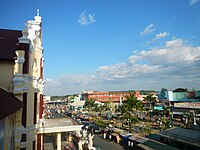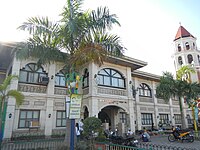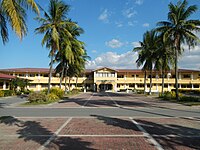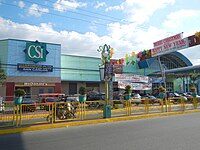San Carlos, Pangasinan
This article needs additional citations for verification. (September 2013) |
San Carlos
Binalatongan | |
|---|---|
Component city | |
| City of San Carlos | |
 Downtown area | |
 Flag  Seal | |
| Nickname(s): Heart of Pangasinan Linguistical center of the Pangasinan language | |
 Map of Pangasinan with San Carlos highlighted | |
show OpenStreetMap | |
 San Carlos Location within the Philippines | |
| Coordinates: 15°55′41″N 120°20′56″E / 15.92806°N 120.34889°ECoordinates: 15°55′41″N 120°20′56″E / 15.92806°N 120.34889°E | |
| Country | Philippines |
| Region | Ilocos Region |
| Province | Pangasinan |
| District | 3rd district |
| Founded | 1578 |
| Cityhood | January 1, 1966 |
| Barangays | 86 (see Barangays) |
| Government | |
| • Type | Sangguniang Panlungsod |
| • Mayor | Julier C. Resuello |
| • Vice Mayor | Joseres S. Resuello |
| • Representative | Rose Marie J. Arenas |
| • City Council | show
Members |
| • Electorate | 111,170 voters (2019) |
| Area | |
| • Total | 169.03 km2 (65.26 sq mi) |
| Elevation | 12 m (39 ft) |
| Highest elevation | 172 m (564 ft) |
| Lowest elevation | 0 m (0 ft) |
| Population (2020 census) [3] | |
| • Total | 205,424 |
| • Density | 1,200/km2 (3,100/sq mi) |
| • Households | 40,867 |
| Economy | |
| • Income class | 3rd city income class |
| • Poverty incidence | 12.27% (2015)[4] |
| • Revenue | ₱606,804,968.75 (2016) |
| Service provider | |
| • Electricity | Central Pangasinan Electric Cooperative (CENPELCO) |
| Time zone | UTC+8 (PST) |
| ZIP code | 2420 |
| PSGC | |
| IDD : area code | +63 (0)75 |
| Climate type | tropical monsoon climate |
| Native languages | Pangasinan Ilocano Tagalog |
| Website | sancarloscitypangasinan |
San Carlos, officially the City of San Carlos (Pangasinan: Siyudad na San Carlos; Ilocano: Siudad ti San Carlos; Tagalog: Lungsod ng San Carlos), is a 3rd class component city in the province of Pangasinan, Philippines. According to the 2020 census, it has a population of 205,424 people. [3]
It is the most populated city in Pangasinan and the entire Ilocos Region.
History[]
San Carlos was already a prosperous community since pre-colonial times. It was formerly part of a town called "Binalatongan". Binalatongan was the capital of Luyag na Caboloan, an ancient kingdom, which includes the present-day provinces of Tarlac, Zambales, Nueva Ecija, La Union, Pangasinan, and Benguet) ruled by King Ari Kasikis. The name of Binalatongan was derived from the abundance of mongo (mung bean) plants along the San Juan riverbanks. During that time, Pangasinan traded with Japan, China and other Southeast Asian empires and national entities and enjoyed full independence and prosperity.[citation needed]
Caboloan is the name of the primitive Pangasinan dialect, of which its purest form was spoken by the natives of Binalatongan.[citation needed]
In 1718, Binalatongan was renamed (the Municipality [town] of) San Carlos.[citation needed]
During the 1960s, the Municipality of San Carlos divided into two precincts. In 1965, the smaller precinct became legally incorporated as the Municipality of Basista by virtue of RA 4866.[5] In 1966, the larger precinct became legally incorporated as San Carlos City by virtue of Republic Act No. 4487.[6]
On April 28, 2007, San Carlos City's former mayor, Julian V. Resuello, was assassinated during an event at the city's plaza. He later died after two days.[7]
Geography[]
Barangays[]
San Carlos is politically subdivided into 86 barangays.
- Abanon
- M.Soriano St. (Poblacion)
- Agdao
- Anando
- Antipangol
- Aponit
- Bacnar
- Balaya
- Balayong
- Baldog
- Balite Sur
- Balococ
- Bani
- Bocboc
- Bugallon-Posadas Street (Poblacion)
- Bogaoan
- Bolingit
- Bolosan
- Bonifacio (Poblacion)
- Buenglat
- Burgos-Padlan (Poblacion)
- Cacaritan
- Caingal
- Calobaoan
- Calomboyan
- Capataan
- Caoayan-Kiling
- Cobol
- Coliling
- Cruz
- Doyong
- Gamata
- Guelew
- Ilang
- Inerangan
- Isla
- Libas
- Lilimasan
- Longos
- Lucban (Poblacion)
- Mabalbalino
- Mabini (Poblacion)
- Magtaking
- Malacañang
- Maliwara
- Mamarlao
- Manzon
- Matagdem
- Mestizo Norte
- Naguilayan
- Nelintap
- Padilla-Gomez (Poblacion)
- Pagal
- Palaming
- Palaris (Poblacion)
- Palospos
- Pangalangan
- Pangoloan
- Pangpang
- Paitan-Panoypoy
- Parayao
- Payapa
- Payar
- Perez Boulevard (Poblacion)
- PNR Site (Poblacion)
- Polo
- Quezon Boulevard (Poblacion)
- Quintong
- Rizal Avenue (Poblacion)
- Roxas Boulevard (Poblacion)
- Salinap
- San Juan
- San Pedro (Poblacion)
- Sapinit
- Supo
- Talang
- Taloy (Poblacion)
- Tamayo
- Tandoc
- Tarece
- Tarectec
- Tayambani
- Tebag
- Turac
- Ano
- Tandang Sora (Poblacion)
Climate[]
| hideClimate data for San Carlos | |||||||||||||
|---|---|---|---|---|---|---|---|---|---|---|---|---|---|
| Month | Jan | Feb | Mar | Apr | May | Jun | Jul | Aug | Sep | Oct | Nov | Dec | Year |
| Average high °C (°F) | 31 (88) |
31 (88) |
31 (88) |
33 (91) |
32 (90) |
32 (90) |
30 (86) |
30 (86) |
30 (86) |
31 (88) |
31 (88) |
31 (88) |
31 (88) |
| Average low °C (°F) | 21 (70) |
21 (70) |
22 (72) |
24 (75) |
24 (75) |
24 (75) |
23 (73) |
23 (73) |
23 (73) |
23 (73) |
23 (73) |
22 (72) |
23 (73) |
| Average precipitation mm (inches) | 5.1 (0.20) |
11.6 (0.46) |
21.1 (0.83) |
27.7 (1.09) |
232.9 (9.17) |
350.8 (13.81) |
679.8 (26.76) |
733.1 (28.86) |
505 (19.9) |
176.6 (6.95) |
67.2 (2.65) |
17.7 (0.70) |
2,828.6 (111.38) |
| Average rainy days | 3 | 3 | 3 | 4 | 14 | 18 | 23 | 25 | 22 | 15 | 8 | 4 | 142 |
| Source: World Weather Online[8] | |||||||||||||
Demographics[]

| Year | Pop. | ±% p.a. |
|---|---|---|
| 1903 | 27,166 | — |
| 1918 | 35,780 | +1.85% |
| 1939 | 47,334 | +1.34% |
| 1948 | 61,671 | +2.98% |
| 1960 | 73,900 | +1.52% |
| 1970 | 84,333 | +1.33% |
| 1975 | 90,882 | +1.51% |
| 1980 | 101,243 | +2.18% |
| 1990 | 124,529 | +2.09% |
| 1995 | 134,039 | +1.39% |
| 2000 | 154,264 | +3.06% |
| 2007 | 161,884 | +0.67% |
| 2010 | 175,103 | +2.90% |
| 2015 | 188,571 | +1.42% |
| 2020 | 205,424 | +1.70% |
| Source: Philippine Statistics Authority [9] [10] [11][12] | ||
Economy[]
| Poverty Incidence of San Carlos | |
| Source: Philippine Statistics Authority[13][14][15][16][17][18] | |

The city is also called the "Mango-Bamboo Capital of the Philippines", San Carlos has the largest number of mango trees - their fruits are among the most flavorsome in the country - and a thriving bamboocraft industry. An agro-industrial city, San Carlos also engages in livestock raising, crop production, inland fishing, pottery, food processing, tourism, commerce and trade, small-scale manufacturing, and flour-making. San Carlos is said to have an ideal investment potential because of its large land area, big population and strategic location, being in the center of Pangasinan.
Tourism[]

Interesting spots of the town include:
- 424-year-old Saint Dominic de Guzman Parish Church
- Speaker Eugenio Perez Memorial Park
- City Plaza
- Quadricentennial Arch in Bolingit
- Binalatongan Ruins in San Juan
- Philippine Fruit Corporation at Barangay Pagal
Giant mango pie[]
On April 26, 2011, 86 barangays in San Carlos baked a 100-square-meter mango pie — filling a gymnasium and setting the largest mango pie world record (400 sqm na mango pie, iniluto sa San Carlos City). Natives used 400 trays of mango pies (10 kilos each, P 400,000, in a 100-square-meter table and shared by more than 1,200). It highlighted San Carlos City's Mango-Bamboo Festival 2011.[19][20][21][22]
Transportation[]
Bus companies with service to and from Manila include Five Star Bus Company, Dagupan Bus Company, Fermina Express, Pangasinan Solid North Transit, Inc., First North Luzon Transit, .
Jeepneys are available for commuters to its neighboring towns, like Calasiao and Malasiqui. Tricycles are available for commuters to barrios and barangays.
Image gallery[]
View of the city from the Bell Tower
Eugenio Pérez Memorial Building, Museum
Kaluyagan Rural Bank and Palaris Colleges School (JT Baun Building)
Pangasinan Provincial Hospital
References[]
- ^ City of San Carlos | (DILG)
- ^ "2015 Census of Population, Report No. 3 – Population, Land Area, and Population Density" (PDF). Philippine Statistics Authority. Quezon City, Philippines. August 2016. ISSN 0117-1453. Archived (PDF) from the original on May 25, 2021. Retrieved July 16, 2021.
- ^ Jump up to: a b Census of Population (2020). "Region I (Ilocos Region)". Total Population by Province, City, Municipality and Barangay. PSA. Retrieved 8 July 2021.
- ^ https://psa.gov.ph/sites/default/files/City%20and%20Municipal-level%20Small%20Area%20Poverty%20Estimates_%202009%2C%202012%20and%202015_0.xlsx; publication date: 10 July 2019; publisher: Philippine Statistics Authority.
- ^ "Republic Act No. 4866 - An Act Declaring Basista, Province of Pangasinan, Created by Executive Order Numbered Four Hundred Forty-Six Dated September Five, Nineteen Hundred Sixty-One, as a Duly Constituted Municipality". laws.chanrobles.com. Chan Robles Virtual Law Library. 8 May 1967. Retrieved 21 November 2019.
- ^ "Republic Act No. 4487 - An Act Creating the City of San Carlos in Pangasinan". laws.chanrobles.com. Chan Robles Virtual Law Library. 19 June 1965. Retrieved 21 November 2019.
- ^ Myds Supnad (2 May 2007). "Cops identify gunman in killing of San Carlos mayor". The Philippine Star. Philstar Global Corp. Retrieved 21 November 2019.
- ^ "San Carlos, Pangasinan: Average Temperatures and Rainfall". World Weather Online. Retrieved 31 October 2015.
- ^ Census of Population (2015). "Region I (Ilocos Region)". Total Population by Province, City, Municipality and Barangay. PSA. Retrieved 20 June 2016.
- ^ Census of Population and Housing (2010). "Region I (Ilocos Region)". Total Population by Province, City, Municipality and Barangay. NSO. Retrieved 29 June 2016.
- ^ Censuses of Population (1903–2007). "Region I (Ilocos Region)". Table 1. Population Enumerated in Various Censuses by Province/Highly Urbanized City: 1903 to 2007. NSO.
- ^ "Province of Pangasinan". Municipality Population Data. Local Water Utilities Administration Research Division. Retrieved 17 December 2016.
- ^ "Poverty incidence (PI):". Philippine Statistics Authority. Retrieved 28 December 2020.
- ^ https://psa.gov.ph/sites/default/files/NSCB_LocalPovertyPhilippines_0.pdf; publication date: 29 November 2005; publisher: Philippine Statistics Authority.
- ^ https://psa.gov.ph/sites/default/files/2003%20SAE%20of%20poverty%20%28Full%20Report%29_1.pdf; publication date: 23 March 2009; publisher: Philippine Statistics Authority.
- ^ https://psa.gov.ph/sites/default/files/2006%20and%202009%20City%20and%20Municipal%20Level%20Poverty%20Estimates_0_1.pdf; publication date: 3 August 2012; publisher: Philippine Statistics Authority.
- ^ https://psa.gov.ph/sites/default/files/2012%20Municipal%20and%20City%20Level%20Poverty%20Estima7tes%20Publication%20%281%29.pdf; publication date: 31 May 2016; publisher: Philippine Statistics Authority.
- ^ https://psa.gov.ph/sites/default/files/City%20and%20Municipal-level%20Small%20Area%20Poverty%20Estimates_%202009%2C%202012%20and%202015_0.xlsx; publication date: 10 July 2019; publisher: Philippine Statistics Authority.
- ^ Manila Bulletin
- ^ "Giant mango pie aims for Guinness world record". ABS-CBN News.
- ^ BP: 400 sqm na mango pie, iniluto sa San Carlos City | Balita Pilipinas | GMA News Online
- ^ Largest Mango Pie: Philippines sets world record
External links[]
| Wikivoyage has a travel guide for San Carlos (Pangasinan). |
| Wikimedia Commons has media related to San Carlos, Pangasinan. |
- San Carlos, Pangasinan
- Cities in Pangasinan
- Populated places established in 1578
- 1578 establishments in the Philippines
- Populated places on the Agno River
- Component cities in the Philippines







